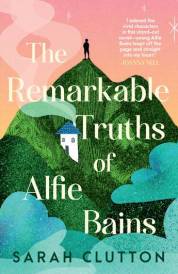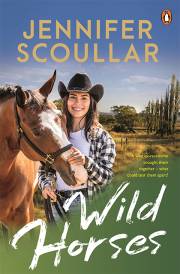Alex Mackay's Cookbook For Everybody Everyday
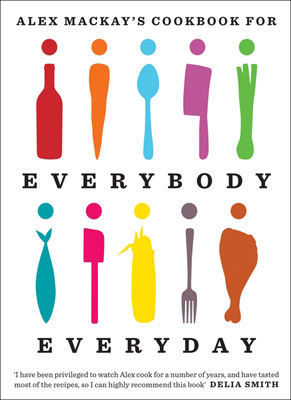
Alex Mackay's Cookbook For Everybody Everyday
Alex Mackay believes that cooking is an adventure and that good food should be for everyone. You don't have to spend a fortune on hard-to-come-by ingredients or have an encyclopaedic knowledge of cooking methods to eat well and healthily. Alex knows that most of us shop in the supermarket and work from nine to five. The trick is to know a few basic recipes inside-out and to reinvent them so they never grow tired.Everybody, Everyday is divided into three parts: basic main ingredients, essentials for the fridge and slow-cooked dishes. Every part is a selection of 'hero' recipes, each followed by six delicious variations. So, once you know how to bake salmon fillets, it's a short step to baked salmon with fennel, olives, warm balsamic and tomato dressing or five other options.
Homemade basil pesto can become mozzarella and pesto meatballs with roast garlic, tomato and peppers; beef rump with pesto, grainy mustard, beetroot and pak-choi; no sweat pesto risotto with sautéed vegetables and sunblush tomatoes; spinach, crème fraiche, penne, parmesan and pesto bake; lamb shoulder chops with fried new potatoes, cherry tomatoes, olives and pesto; braised sea bass fillets with beans, peas and pesto. Imagine what can be done with roast duck, mackerel fillets, caramelised onions, garlic butter and the rest of the heroes...
With 126 adaptable recipes, this really is a book for everybody who wants to cook delicious food everyday - be they young, old, single, part of a large family, new to cooking or an old hand. Let the adventure begin!
Alex Mackay has worked as a chef at Michelin-starred restaurants in France, Italy and the UK. Having run Raymond Blanc's cookery school and founded the internationally acclaimed Baou d'Infer cookery school in Provence, he now teaches alongside Delia Smith.
Alex lives near Oxford. His first book Cooking in Provence was a winner at the Gourmand World Cookbook Awards.
Alex Mackay's Cookbook For Everybody Everyday
Bloomsbury
Author: Alex Mackay
ISBN: 9781408810934
Price: $39.99
Buy it now
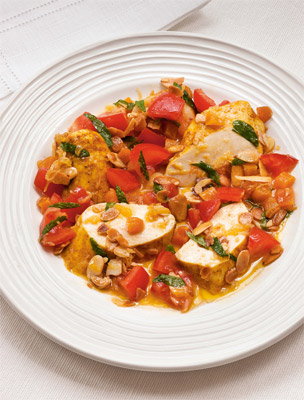
Curried Chicken Breasts with Lemon and Almond Dressing
Serve with tasty grains or chickpeas and/or leafy vegetablesPrepare ahead Dressing, except mint. Spice mixture, 4 hours ahead
Prep/cooking 35-40 minutes
Active time 20-25 minutes
Ingredients
6 tbsp orange juice (fresh or from a carton)
Zested or grated zest and juice of 1 lemon (4 tbsp)
1 garlic clove, peeled and finely chopped
2 tsp grated ginger
1 tsp curry powder
1/2 tsp ground turmeric
2 skinless, boneless chicken breasts, about 150g each
3 heaped tbsp flaked almonds
4 tbsp extra virgin olive oil
8 dried apricots, chopped into 1cm pieces
2 large plum tomatoes, cut into 1cm dice
4 tbsp sliced mint
4 tbsp plain yoghurt
Salt and sugar
Method
Preheat your oven to 200�C/Gas 6, position upper middle shelf.
Start with the spice mixture. Get a medium-sized ovenproof frying pan. Add the orange juice, lemon zest, lemon juice, garlic, ginger, curry powder and turmeric. Put the pan on a high heat. Bring to the boil and boil for 1 minute or until the mixture is just thick enough to lightly coat the back of a spoon. Take the pan off the heat.
Get a baking tray. Put the chicken breasts on the tray. Spoon 1 tbsp of the spice mixture over each chicken breast. Brush the mixture all over both sides of the breasts. Season with salt. Bake for 9 minutes.
Take the tray out of the oven. Sprinkle the almonds on the tray next to the pointy ends of the breasts. Put the tray back into the oven for 5-7 minutes (or as much extra time as the larger weights need, removing the almonds when they are toasted).
While the chicken bakes, make the dressing. Get a medium bowl. Add the extra virgin olive oil, dried apricots, tomatoes and mint.
Once the chicken breasts are baked, get them out of the oven. Add them and the almonds to the spice mixture in your pan. Turn the breasts in the mixture until they are well coated. Turn the oven off. Put the pan back in the oven and leave the door slightly ajar. Let the chicken rest for 5 minutes.
Roll the chicken breasts in the pan juices and almonds. Thickly slice the breasts (or leave them whole if you prefer). Put the chicken on your plates. Use a heatproof spatula to scrape the sticky pan juices and almonds into the dressing. Season to taste with salt and sugar. Spoon the dressing over the chicken breasts. Serve the yoghurt in a bowl on the side.
Bake extra chicken breast(s) and leave them to cool in the citrus mixture. Chop the breasts and mix with the equivalent extra dressing for a pita bread or salad with tasty grains and/or crisp lettuce, peppers or cucumber.
Alex's Comments
"My time in Provence taught me that citrus is the sunshine seasoning. Years of cooking and tasting showed me that it can sometimes have more impact when its sharp flavour is softened. I boil the lemon and orange juice in this recipe to make it more concentrated, just sour enough to refresh and just sweet enough to revitalise. The chicken is then more intensely flavoured but less overpowered by citrus than if the juice was raw. The curry and turmeric add a jolly little twang; feel free to add more if you like it hot. For younger kids, leave out or put in less of the spice mixture and chop the mint very finely. Add the almonds to your dressing but not theirs, then give the kids a taste. Without the almonds this is good to puree or chop and freeze for babies and toddlers."
Interview with Alex Mackay
Question: Why did you decide to use your knowledge of food to create a cookbook for everybody on every day?Alex Mackay: What inspired me was 16 years of questions from home cooks that I have taught and I believe I have become more of a cook and less of a chef, myself, especially since I've had kids. I understand because I am faced with the challenges that home cooks have and I wanted to find a unique way that involved a certain degree of repetition on helping people learn how to cook.
I wanted to take out any panic elements; by nature I am the messiest and most chaotic cook (a tornado cook) and when I do demonstrations I am very tidy and the reason for that is because I lay everything out in front of me, all measured in bowls which is the most practical thing in the world because you have all your utensils and ingredients in front of you! When you're cooking the thing that makes you panic isn't the cooking but turning around to look for something you don't have whilst something is boiling over or burning.
I recently did a demonstration for the launch of the book and I prepared all the ingredients and utensils then had a volunteer come up and cook whilst I told her what to do and she was able to cook three salmon dishes in 25 minutes.
Question: Why did you choose to separate the book into three parts?
Alex Mackay: It was important to separate the book into the three distinct ways which originally were going to be three separate books however I am very glad we put all three into one book.
I have the crystal clear idea that you need to get used to cooking whether it is pasta, pork chop, chicken or any ingredient that you cook the same way, each time but you season it differently and serve it with different things and you become used to it; similar to a piece of toast where you just change the topping. Changing the topping could be as simple as doing Cajun and pepper instead of salt and pepper or salt and Chinese Five Spice. The first section of the book is about encouraging people to try different things to become more confident and getting used to the fact that changing things slightly will have the dish tasting totally different. All of the dishes look really nice too as that's always great for people's confidence. All the recipes give an idea of how long it will take to cook, what (if anything) it should be served with it and what can be prepared ahead.
The Magic Fridge came from when I had the school in the south of France where after doing a sit down dinner on the first night I felt it was too formal; I then began buffets which was great because everyone would pass around food and chat which really broke the ice. Although with the buffet we'd have tonnes of meals left over and the fridge in the demonstration room was full of roasted peppers, tomatoes and many different types of foods. A student would ask "What is good to serve with�" and I would say "go to the magic fridge and get something out"! The Magic Fridge was so handy and useful for the students who would come from all over the world include Manhattan and Sydney. Having your own Magic Fridge or Freezer is really practical and in Cookbook For Everybody Everyday there are pages of simple magic and then six recipes such as Eggs and Potatoes cooked with Tomato Compost. The Magic Fridge section contains quick ideas that instead of starting with ingredients, you are starting with a preparation.
The Slow Cook Saucery is because I love leftovers and this section is about creating leftovers on purpose. My wives late grandfather was around for 12 years after his wife who did all the cooking and he loved roasts but he'd never cook that for himself because it wasn't economical instead I showed him how to get a good amount of potions out of a chicken or lamb because if it's only for one or two people, it's still a good idea to cook the whole thing because then you have fantastic leftovers that you created on purpose. I was very careful with the recipes that they didn't end up tasting like a slightly different version of each other such as Roast Chicken with Black Pudding and Apples or Roast Chicken with Fennel, Chilli and Grapefruit. Sometimes when you come home from work the idea that you can take something from the freezer and you already have the bulk of a meal is fantastic and incredibly satisfying because you've done it yourself.
Question: How did you go about testing the recipes for the cookbook?
Alex Mackay: When I was testing the recipes at home we would choose a chapter each, I might choose Pesto, my eldest son who was 4 at the time would choose Mackerel from the Slow Cook section (because he loves Mackerel) and my wife might choose a Chicken Breast and I would work on those recipes until they were completed. There were some times when we ate chicken six nights in a row as there could have been one dish that I couldn't quite get and I was still testing, testing, testing! These dishes are all a part of our lives, I didn't just write them for the book these are dishes we enjoy all the time - they're friends of the family.
Question: Which recipe from the book holds the most memories, for you?
Alex Mackay: Each recipe has an introduction and have all come from somewhere special. I am really crazy about spending time with my kids and James' Pasta Butterflies, Jake's Meatballs and Casey's Barbeque Chicken are three of my favourites because the kids had a lot to do with those three dishes (however they had a lot to do with all the dishes); those three dishes are super doper extra special because they have my kids names on them.
On my website www.everybodyeveryday.co I have extras for each recipe including a blog about how the kids reacted when we made certain dishes as well as a list of job kids can do for each recipe because I am for everyday cooking with kids. The jobs include spreading butter on bread, cracking eggs, grinding pepper, squeezing lemon, setting the table and doing things with measuring cups and spoons. I cut the top off an onion and begin to peel back the skin so they can finish peeling which is incredibly satisfying at any age.
Question: I'm having guests over for dinner this weekend, what should I cook, for them?
Alex Mackay: The Braised Shoulder of Lamb especially because it will sit there, quiet happily, for a long time and make sure you brush it with the gravy like I talk about in the book. The Braised Shoulder of Lamb is very easy to eat and in the book I show you how to cut it up, but with family you can put it on the middle of the table and take a pair of tongs and the meat is so soft it will come away. It's a warming dish for winter.
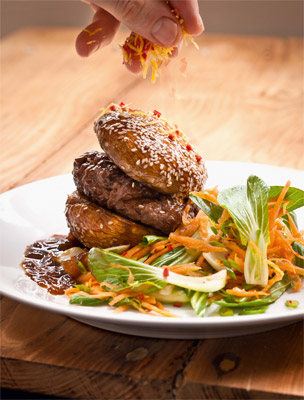
Ginger Burger with Mushroom 'Buns' and Chinese Coleslaw
Serve with: Prawn crackers or popcorn with hoisin or soy sauceServes 2
Prep/cooking 30 minutes
Active time 20-25 minutes
Ingredients
4 very large mushrooms
2 tbsp honey
2 tbsp hoisin sauce
1 tbsp plus 3 tsp sesame oil
Zested or grated zest of 1 small lemon and 2 tbsp juice
2 tbsp sesame seeds
6 spring onions, trimmed
1 medium carrot, peeled and grated
1 head of pak choi, leaves and stalks roughly cut
1 mild red chilli, deseeded and finely chopped
350g beef mince
2 tsp grated ginger
3 tbsp water
Salt and sugar
Method
Preheat your oven to 220�C/Gas 7, position upper middle shelf.
Start with the mushrooms. Get a baking tray. Put the mushrooms on the tray. Get a small bowl. Add the honey, hoisin sauce, the 1 tbsp of sesame oil and 1 tbsp of the lemon juice. Whisk together. Brush the mushrooms all over with a third of this mixture. Season with salt. Turn the mushrooms rounded side up. Sprinkle with sesame seeds. Roast for 10 minutes. Turn off the oven and leave the mushrooms inside with the door slightly ajar, to keep warm without overcooking them.
While the mushrooms roast, thinly slice the white part of the spring onions and keep the slices for the burger sauce.
Next, make the Chinese coleslaw. Thinly slice the green spring onion tops diagonally and put the slices into a bowl. Add the grated carrot, pak choi, 1 tsp of sesame oil, the remaining 1 tbsp of lemon juice, half the chilli and half the lemon zest. Season lightly with salt and sugar. Toss together. Put the coleslaw onto one side of each plate.
Mix the mince with the ginger and 1/2 tsp of salt. Pat into 2.5cm thick burgers. Get a medium-sized frying pan. Put it on a high heat. Add the remaining 2 tsp of sesame oil and get it really hot. Add the burgers. For medium-rare burgers, fry over a medium-high heat for 21/4 minutes. Turn and fry for 21/4 minutes on the other side. Brush the burgers with enough of the honey and hoisin mixture to coat them. Turn off the heat. Turn the burgers in the pan until they are sticky and shiny. Put them on the tray in the oven with the mushrooms. Add the chopped white spring onions to the frying pan. Sweat over a medium heat for 30 seconds. Add the rest of the hoisin mixture and the 3 tbsp of water. Boil for 10 seconds or until the sauce is thick enough to coat the back of a spoon. Take the pan off the heat.
Put a mushroom onto each plate, rounded side down. Put a burger on top of each. Spoon the sauce over the burgers and around the mushrooms. Put a second mushroom, rounded side up, on top of each burger. Sprinkle the remaining lemon zest and chilli over the top.
Alex's Comments
"Big mushrooms make marvellous buns. I first came across the idea when I read about Michel Trama's Cepe Burger fifteen years ago and I've been waiting for a chance to use it since. The Chinese coleslaw is part of the fun - pak choi gives you a bright, juicy crunch. If you want a bit of 'cheese', a slice of silken tofu would be nice. These mushrooms could be adapted to suit my other burger recipes for anyone on a wheat-free diet. For younger kids, finely dice the mushrooms. Give them the crunchy pak choi stalks rather than leaves. Leave out the sesame seeds, raw spring onion and chilli, grate lemon zest finely and use less ginger. Good to puree or chop and freeze for babies and toddlers."
Buy it now at
MORE

